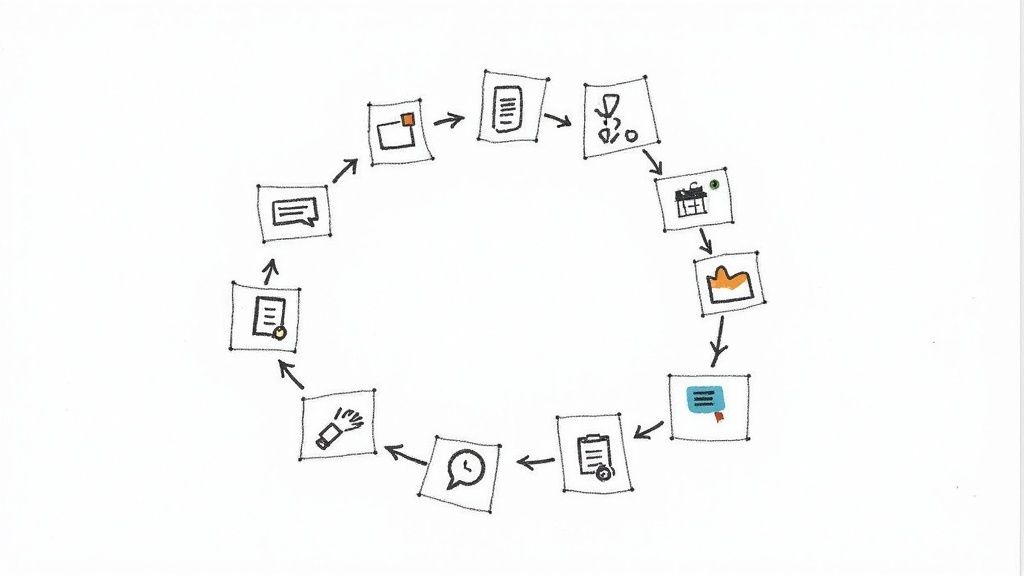Alright, let's be blunt. You’ve posted on every job board known to man, begged your network for referrals until they started blocking your number, and maybe even considered selling a kidney to afford a headhunter. Sound familiar? The old "post and pray" playbook is dead. It’s a soul-crushing cycle of sifting through mountains of mediocre resumes and hoping for a miracle.
But what if you could stop playing the hiring lottery and start engineering your success? What if finding A-players wasn't about luck, but about having a smarter, sharper toolkit? We've been in the trenches. We've made the expensive mistakes. We've figured out what actually moves the needle. And no, we're not talking about the fluffy, "be authentic" advice you’ve read a hundred times. We’re talking about real, battle-tested candidate sourcing strategies that we depend on.
This isn't a lecture. It's a field guide. We’ll break down the methods that work, from the surgical precision of Boolean black belts to the magnetic pull of a killer employer brand. Each strategy comes with no-BS steps you can use today. Time to stop hoping and start hiring.
1. The Codebreaker’s Method: Mastering Boolean Search
Before you roll your eyes, this isn’t your high school librarian's dusty card catalog logic. Think of Boolean search as your secret weapon for cutting through digital noise. It’s the difference between yelling into a crowded stadium and whispering directly into the right person's ear. If your recruiters can't build a decent search string, you're just paying them to scroll through endless, irrelevant profiles. It's that simple.

Mastering this is one of the most fundamental and shockingly cost-effective candidate sourcing strategies you can deploy. It transforms a generic LinkedIn search into a surgical strike. Using simple operators like AND, OR, and NOT, you can pinpoint exactly the talent you need with astonishing precision.
How to Implement It
The core principle is combining terms to refine your search. Think of it less like searching and more like building a logical command. A deep understanding of how to keyword research is fundamental here, as it teaches you to think in synonyms, related skills, and how real people describe themselves.
- LinkedIn Recruiter Example: For a mid-level software developer, don't just type "Software Developer." Build a string like:
("Software Engineer" OR "Software Developer") AND (Java OR Python) AND "REST API" NOT (Junior OR "Jr." OR Intern) - Google X-Ray Search Example: To find a product manager at a specific company, you can search Google directly:
site:linkedin.com/in/ "Product Manager" "at HubSpot" - Indeed Resume Example: Searching for a marketing specialist? Use a string like:
("Marketing Specialist" OR "Marketing Coordinator") AND (SEO OR "Content Marketing") AND (HubSpot OR Marketo)
Pro-Tips for Success
- Start Broad, Then Narrow: Begin with a wide search (
Java AND developer) and progressively add terms (AND "microservices" NOT manager) to chisel away the noise. - Use Parentheses: Group related terms with
()to control the search logic. Just like in 8th-grade math. It works. - Save Your Strings: Don’t reinvent the wheel. Save successful and complex search strings in a shared doc. Your team can reuse and adapt them.
2. Social Media Recruiting
If you think social media is just for sharing lunch photos and arguing with strangers, you’re leaving a goldmine of talent on the table. Social media recruiting isn’t about spamming “we’re hiring” banners into the void. It’s about meeting candidates where they already live, building genuine connections, and showing them why your company is a place they’d actually want to work. This is how you find the passive superstars who aren’t scrolling job boards but are open to a compelling offer.

This strategy turns recruitment from a cold transaction into a warm conversation. Platforms like LinkedIn, Twitter, and even niche Discords let you see beyond a resume to a candidate’s passions, communication style, and cultural fit. This is one of the most effective candidate sourcing strategies for building a long-term talent pipeline, not just filling an immediate hole.
How to Implement It
Success here hinges on authenticity. Don’t just copy-paste the same message everywhere. It's about being human first, recruiter second. Your goal is to build a reputation that attracts talent organically.
- The LinkedIn Play: Go beyond job posts. Share insightful articles from your team leads, comment thoughtfully on industry leaders' posts, and use targeted outreach to connect with people who engage with relevant content. Microsoft does this masterfully, using its leaders' profiles to share thought leadership that naturally attracts talent.
- The Twitter Game: Engage in industry conversations using relevant hashtags (#FinTech, #WomenInTech). Salesforce is known for using Twitter to engage with tech talent in real-time, making the company feel accessible and current.
- The Instagram Angle: Use Stories and Reels for a behind-the-scenes look at your culture. Showcase team events, employee spotlights, and a day-in-the-life. This attracts candidates who value a strong workplace vibe, much like how HubSpot uses its feed to build its employer brand.
Pro-Tips for Success
- Be a Giver, Not a Taker: Share valuable content and offer advice without immediately asking for something. Build rapport before you build a candidate list.
- Equip Your Army: Encourage your team to be brand ambassadors. Their authentic posts are infinitely more powerful than any corporate announcement.
- Track What Matters: Forget follower counts. Are people commenting? Sharing your content? That’s the real sign of a healthy employer brand.
3. Employee Referral Programs
Your best people know other great people. Simple truth, right? Yet so many companies screw this up with a program so clunky it feels like filing your taxes. A well-designed employee referral program isn't just handing out cash for names; it’s one of the most potent candidate sourcing strategies because it turns your entire team into a proactive, high-quality recruitment engine. These aren’t cold leads; they’re pre-vetted candidates recommended by someone who already knows what it takes to succeed at your company.

This approach leverages trust to deliver candidates who tend to onboard faster, perform better, and stay longer. Instead of shouting into the job board void, you’re tapping into a curated talent pool. Companies like Google, which offers huge bonuses, and Zappos, which focuses on cultural fit, have proven this pays massive dividends.
How to Implement It
The $500 Hello. The goal is to make referring someone almost an impulse. Remove every ounce of friction. A confusing submission process or a six-month payout delay will kill your program before it starts. You need a system that is transparent, rewarding, and dead simple.
- Formalize It: Use a simple form or a dedicated platform (like Teamable or ERIN) where employees can submit referrals, track their status, and see the reward. Don't let referrals die in email chains or Slack DMs.
- Tier the Rewards: Not all roles are created equal. A successful referral for a hard-to-fill senior engineer might earn a $5,000 bonus, while an admin role might be $1,000. Be clear about it.
- Promote It Relentlessly: This isn't a "set it and forget it" tool. Announce new openings in company meetings, feature "most wanted" roles in your internal newsletter, and celebrate successful referrals publicly to keep the momentum going.
Pro-Tips for Success
- Make It Effortless: The submission process should take less than two minutes. Give employees pre-written job descriptions and social media posts they can easily share.
- Reward the Attempt: Don't just reward the hire. Offer small incentives, like a $50 gift card, for any referred candidate who makes it to a final-round interview. This encourages quality over quantity.
- Close the Loop: If a referral isn't a fit, give your employee a brief, respectful reason why. It shows you value their effort and helps them send better candidates next time.
4. Talent Pipeline Development
Stop thinking of recruiting as a one-off transaction. That's like trying to build a house one brick at a time, but only buying a brick right when you need to lay it. Ridiculous, right? Talent pipeline development is the strategic shift from reactive hiring to proactive relationship-building. You're not just filling today's role; you're cultivating a network of pre-vetted, engaged talent for tomorrow's needs.

This approach transforms your hiring from a desperate scramble into a well-oiled machine. It means creating databases of qualified pros, nurturing those connections, and positioning your company as an employer of choice long before an opening exists. Instead of starting from scratch every time, you have a warm bench of candidates who already know and respect your brand.
How to Implement It
The goal is to build communities, not just lists. Think of it as your company’s exclusive talent club. You can start by systematically identifying high-potential people and creating dedicated channels to engage them. If you're serious, a deeper dive into talent pipeline management is essential to turn this concept into a core business function.
- Amazon’s Technical Communities: Amazon creates talent communities for in-demand roles like SDEs, engaging them with tech talks, newsletters, and early access to job postings.
- Johnson & Johnson's Early Career Programs: They build pipelines from the ground up by partnering with universities, offering internships, and maintaining relationships with alumni, ensuring a steady flow of entry-level talent.
- Deloitte’s University Partnerships: Deloitte actively nurtures relationships with top business and tech schools, hosting exclusive events and workshops to identify future consultants before they even hit the job market.
Pro-Tips for Success
- Segment Your Pipelines: Don’t lump everyone together. Create distinct pipelines for "Senior Backend Engineers," "Product Marketing Leaders," and "Future Sales Directors."
- Use Marketing Automation: Leverage tools like HubSpot or Mailchimp to send targeted, valuable content. Think industry insights and company news, not just "We're hiring!" spam.
- Provide Real Value: Host exclusive webinars or share internal research. Give them a reason to stay engaged beyond the promise of a future job.
- Maintain Your Records: Use your ATS or a CRM to track every interaction. Note their career goals and interests to make future outreach personal and effective.
5. The Digital Headhunter: AI-Powered Candidate Matching
If you think AI in recruiting is just a chatbot asking, “How can I help you?” you're missing the revolution. AI-powered candidate matching is the digital headhunter that never sleeps, eats, or complains about bad coffee. It’s leveraging machine learning to sift through thousands of profiles, resumes, and data points to find the perfect fit before your human recruiters have finished their first espresso. For high-volume hiring, this is one of the most powerful candidate sourcing strategies there is.
This isn't about replacing human intuition; it's about supercharging it. These systems analyze job requirements, candidate profiles, and historical hiring data to predict success with unnerving accuracy. They can screen resumes, find top talent in your existing database, and serve up a shortlist of candidates who are not just qualified but optimally matched.
How to Implement It
Let the algorithm do the heavy lifting so your team can focus on the human element: building relationships. It starts by feeding the AI a rich diet of data. The more it knows about your ideal hire, the smarter its recommendations become. When it's working, you'll slash your time-to-hire. For a deeper look into the mechanics, you can learn more about how automated candidate screening works.
- Screening Resumes at Scale: Use a tool like Ideal or HireVue to instantly screen thousands of inbound applications for a customer service role, ranking them by experience, skills, and even sentiment.
- Talent Rediscovery: Plug an AI tool into your ATS to re-engage past "silver medalist" candidates. The system might find a past software engineer applicant who now has the exact "Go" experience you need for a new role.
- Predictive Success Modeling: Companies like Unilever use platforms like Pymetrics, which uses neuroscience games to assess cognitive and emotional traits, matching them to roles where they are statistically likely to thrive.
Pro-Tips for Success
- Audit for Bias, Religiously: AI is only as unbiased as the data it's trained on. Regularly audit your system to ensure it's not inadvertently filtering out diverse candidates.
- Combine with Human Judgment: Never let the algorithm make the final hiring decision. Use it as a powerful recommendation engine, but trust your team's gut to assess cultural fit and other nuances.
- Start with a Pilot Program: Don't go all-in at once. Test an AI tool on a single, high-volume role first. Measure the results, refine, and then scale.
6. Industry Event Networking
Let’s be honest, most people treat conferences like a company-sponsored vacation with free lanyards. But for a sharp recruiter, these events are pure gold. Industry event networking isn't about collecting business cards to gather dust on your desk; it's about playing the long game. You're not there to hand out job offers. You're there to build genuine connections, identify passive A-players who aren't even looking, and position your company as the place to be.
This is one of the more personal and high-touch candidate sourcing strategies. It transforms talent acquisition from a transactional process into a relationship-building one. By showing up where the experts gather, you gain credibility and access to talent pools that are invisible on job boards. Think of it as moving from cold outreach to warm introductions, all while enjoying a few keynote speeches.
How to Implement It
Success here is less about a flashy booth and more about strategic engagement. Your goal is to be a resource, not just a recruiter. To excel at this, adapt the same mindset used by top sales pros; many of their proven business networking strategies translate directly to building a robust talent pipeline.
- Pre-Event Recon: Use the event app or LinkedIn to identify key speakers and attendees. Who are the innovators? Make a shortlist of 10-15 people you want to connect with.
- Be a Giver, Not a Taker: Instead of leading with "We're hiring," start by offering value. Compliment a speaker on their talk, ask an insightful question, or connect two people who could benefit from knowing each other.
- Strategic Follow-Up: Don't let connections go cold. Send a personalized LinkedIn request or email within 48 hours referencing your conversation. Example: "Hi [Name], great chatting about [Topic] at [Event]. I really enjoyed your perspective on [Specific Point]. Let's stay in touch."
Pro-Tips for Success
- Set Clear Goals: Don't just "go to network." Set specific goals like: "Have 5 meaningful conversations with senior engineers" or "Identify 3 potential speakers for our next company tech talk."
- Divide and Conquer: If you send a team, assign different goals or tracks to each person. One can focus on junior talent while another connects with leaders at a VIP dinner.
- Listen More Than You Talk: The best way to identify great candidates is to understand their passions, challenges, and career goals. You can only do that by shutting up and listening.
7. Content Marketing for Talent Attraction
Instead of constantly hunting for candidates, what if they came to you? That’s the entire premise behind content marketing for talent attraction. It’s playing the long game by creating valuable, insightful, and genuinely interesting content that showcases your company as the place to work. You stop interrupting candidates and start attracting them.
This isn't about slapping "We're Hiring!" on a generic blog post. This is one of the most powerful inbound candidate sourcing strategies because it builds a pipeline of people who are already bought into your mission and expertise. It positions you as a thought leader, making your company a magnet for ambitious professionals who want to work with the best.
How to Implement It
The goal is to stop selling jobs and start sharing stories and expertise. Think about what your ideal candidates are curious about, what problems they face, or what they aspire to learn. Create content that serves them, and they'll remember you when it's time for a career move.
- The Engineering Blog: Don't just list your tech stack. Write a deep dive on how your team solved a complex scaling problem. Netflix's tech blog is a masterclass in this, attracting top engineers by showcasing the challenging work they do.
- Culture & Values Content: Buffer built its brand on transparency, publishing everything from employee salaries to its remote work policies. This kind of authentic content builds immense trust and attracts candidates who are a perfect cultural fit.
- Employee-Generated Stories: Feature your team. A "Day in the Life" video, a Q&A with a senior leader, or a post by an employee about their career journey is far more compelling than any job description. Shopify's "Life at Shopify" content series does this exceptionally well.
Pro-Tips for Success
- Address Candidate Pain Points: What frustrates professionals in your industry? Unclear career paths? Create content that shows how your company addresses these issues head-on.
- Use Multiple Formats: Not everyone reads blogs. Repurpose ideas into podcasts, short-form videos (TikTok/Reels), or webinars.
- Focus on Employee Stories: Your employees are your most credible brand ambassadors. Their authentic stories about growth and impact are your most potent marketing assets. Let them be the heroes.
8. The Campus Pipeline: Forging University and College Partnerships
If your growth relies on fresh, ambitious talent, waiting for them to find you on a job board is a losing game. You need to get in front of them before they graduate. Building formal relationships with universities isn't just showing up to a career fair; it’s about creating a direct pipeline from the lecture hall to your office. This is your long-term play for cultivating future leaders.
This is one of the most proactive candidate sourcing strategies for companies planning for scale. By embedding your brand within academic communities, you’re not just hiring; you're shaping the next generation of professionals to see your company as the place to be. It’s planting an orchard instead of just buying fruit at the market.
How to Implement It
The goal is to move beyond transactional recruitment and build genuine partnerships. This means engaging with faculty, supporting students, and becoming a recognized presence on campus. Major players like Google and Microsoft have entire divisions for this, but you can get results with a focused approach.
- Internship Programs: Go beyond coffee runs. Design structured, project-based internships that offer real-world experience and a clear path to a full-time offer. This is your best chance to test-drive talent.
- Campus Events & Guest Lectures: Send your top engineers or marketers to give guest lectures or host workshops. This establishes your team as experts and gives students a tangible connection to your company.
- Career Fairs & Sponsored Projects: Career fairs are table stakes. Level up by sponsoring a senior-year capstone project or a hackathon. You get direct access to top-performing students and see their problem-solving skills in action.
Pro-Tips for Success
- Partner with Career Services: The career services office is your gatekeeper. Build a strong relationship with the staff; they can connect you with the right departments, student clubs, and events.
- Create Ambassador Programs: Empower passionate student ambassadors on campus to represent your brand. Their authentic voice is more effective than a corporate flyer.
- Focus on Meaningful Engagement: Don’t just hand out swag. Offer resume review sessions, conduct mock interviews, or provide mentorship. The more value you provide, the more you’ll attract top-tier candidates.
9. The Whisper Campaign: Mastering Passive Candidate Outreach
Active job seekers are the low-hanging fruit, but the real game-changers are often the ones who aren't looking. This is where passive candidate outreach comes in. It’s the art of identifying, engaging, and poaching top-tier talent that is happily employed elsewhere. Think of it less like posting a job ad and more like a strategic intelligence operation.
, Society of Women Engineers (SWE), or Out in Tech. Sponsor events, post on their job boards, and build real relationships.
- Audit Your Job Descriptions: Use tools like Textio or Gender Decoder to scrub your job descriptions of biased language. Words like "rockstar" or "ninja" can deter qualified candidates. Focus on outcomes, not an exhaustive list of qualifications.
- Expand Sourcing Channels: Move beyond LinkedIn. Explore niche job boards like Diversity.com, attend conferences focused on minority professionals, and source from Historically Black Colleges and Universities (HBCUs) or Hispanic-Serving Institutions (HSIs).
Pro-Tips for Success
- Train Your Hiring Teams: Unconscious bias is real and it's probably costing you great hires. Implement mandatory bias training for everyone involved in the hiring process.
- Set Measurable Goals: What gets measured gets managed. Set clear, quantifiable diversity goals for your talent pipeline and hold your team accountable. Track metrics at each stage of the funnel.
- Show, Don’t Just Tell: Ensure your career page and social media reflect a genuinely diverse workplace. Stock photos won't cut it.
Candidate Sourcing Strategies Comparison
| Strategy | Implementation Complexity 🔄 | Resource Requirements ⚡ | Expected Outcomes 📊 | Ideal Use Cases 💡 | Key Advantages ⭐ |
|---|---|---|---|---|---|
| Boolean Search Techniques | Medium – requires syntax knowledge 🔄 | Low – mainly time and skill ⚡ | Precise candidate targeting 📊 | Targeted searches across multiple platforms 💡 | Highly customizable, cost-effective, scalable ⭐ |
| Social Media Recruiting | High – needs social media expertise 🔄 | Medium – time and content creation ⚡ | Access to passive candidates, brand building 📊 | Engaging passive candidates and employer branding 💡 | Builds personal connections, real-time engagement ⭐ |
| Employee Referral Programs | Medium – program setup and tracking 🔄 | Low to Medium – incentives and admin ⚡ | Higher quality hires, faster time-to-hire 📊 | Leveraging employee networks for quality candidates 💡 | Higher retention, better cultural fit, cost-effective ⭐ |
| Talent Pipeline Development | High – requires long-term planning 🔄 | High – ongoing engagement and tools ⚡ | Reduced time-to-fill, improved candidate quality 📊 | Proactive talent pooling for future needs 💡 | Competitive advantage, succession planning ⭐ |
| AI-Powered Candidate Matching | Very High – complex tech integration 🔄 | High – technology and data needs ⚡ | Improved match accuracy, bias reduction 📊 | Large-scale resume screening and predictive hiring 💡 | 24/7 operation, identifies hidden talent ⭐ |
| Industry Event Networking | High – event attendance and follow-up 🔄 | Medium to High – travel and time ⚡ | High-quality personal contacts, brand visibility 📊 | Building relationships at conferences and meetups 💡 | Access to passive candidates, natural networking ⭐ |
| Content Marketing for Talent Attraction | Medium to High – content production 🔄 | Medium – content teams and tools ⚡ | Strong employer brand, attracts passive candidates 📊 | Long-term brand building and candidate engagement 💡 | Thought leadership, cost-effective over time ⭐ |
| University and College Partnerships | Medium – coordination with institutions 🔄 | Medium – events and programs ⚡ | Access to fresh talent, early brand exposure 📊 | Entry-level recruitment and internship pipelines 💡 | Cost-effective, higher new graduate retention ⭐ |
| Passive Candidate Outreach | High – personalized research and messaging 🔄 | Medium – skilled recruiters and time ⚡ | Access to high-quality talent, less competition 📊 | Engaging currently employed professionals 💡 | Better negotiation position, reduced hiring costs ⭐ |
| Diversity and Inclusion Sourcing | High – specialized knowledge and training 🔄 | Medium to High – partnership and training ⚡ | More diverse teams, regulatory compliance 📊 | Building inclusive talent pipelines and innovation 💡 | Enhances reputation, broader talent pools ⭐ |
Stop Admiring the Problem and Start Fixing It
So there you have it. Ten modern candidate sourcing strategies, from Boolean strings to university partnerships. We’ve moved far beyond the days of "post and pray." The modern talent landscape is a competitive arena, and just showing up with a job description is like bringing a spork to a sword fight. You’ll just get messy.
Reading this list is easy. The real work—the part that separates the perpetually-hiring from the high-performers—starts now. The temptation is to try everything at once. Launch a referral program on Monday, hit a career fair on Tuesday, and become a LinkedIn guru by Friday. Don't. It’s a surefire path to burnout and doing everything poorly.
Instead, let’s get pragmatic. Your goal isn’t to boil the ocean. It’s to stop admiring the empty pipeline problem and actually start fixing it.
From Theory to Action: Your First 90 Days
Don't let this list become another browser tab you close and forget. Pick two. Only two. Master them over the next quarter. Which two? It depends on your biggest pain point.
- Is your problem speed? You need candidates, like, yesterday. Focus on Boolean Search and a supercharged Employee Referral Program. These are direct, high-leverage tactics that can produce results in weeks, not months. The goal is immediate impact.
- Is your problem quality? You’re getting applicants, but they’re… not great. Your focus should be on Talent Pipeline Development and Passive Candidate Outreach. This is a longer game, a strategic shift to proactive relationship-building. It’s about cultivating interest long before a role ever opens up.
- Is your problem brand awareness? Great candidates don't even know you exist. Go all-in on Content Marketing and strategic Social Media Recruiting. Showcase your culture, your technical challenges, and the people who make your company great. You're not just recruiting; you're building a following.
Whatever you choose, commit. Define what success looks like. Is it 10 qualified engineering leads from your new Boolean strings? A 50% increase in referred candidates who make it to the final round? Set a tangible goal, track it religiously, and then build from there.
The Real Engine of Modern Sourcing
Ultimately, mastering these candidate sourcing strategies is about creating a system, not just executing tasks. It’s about building a predictable, scalable talent engine that fuels your company’s growth. Each strategy we've covered is a gear in that engine. When they work together, you move from constant panic to strategic control.
The best sourcing systems are a blend of art and science. The art is the human connection, the compelling outreach message, the authentic story. The science is the data, the tools, the repeatable processes. Neglect one, and the whole engine sputters.
The biggest benefit isn't just filling roles faster. It’s the compounding advantage of hiring better people. Better hires build better products, create a stronger culture, and attract even more top talent. That’s the flywheel effect. It all starts with sourcing. So, stop admiring the problem. Pick your focus, commit, and go build your engine.
Ready to supercharge your new sourcing pipeline? Once these strategies start delivering candidates, you need a way to screen them efficiently without losing the personal touch. Async Interview lets you replace time-consuming phone screens with structured, asynchronous video interviews, so your team can focus on the best-fit candidates. Check out how Async Interview can help you build a faster, fairer, and more effective hiring process.




